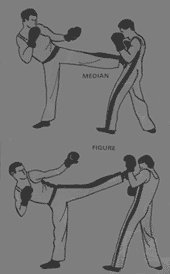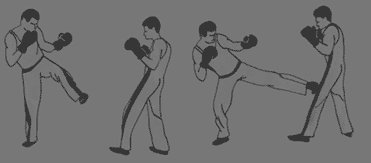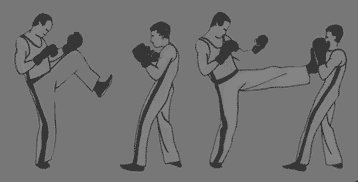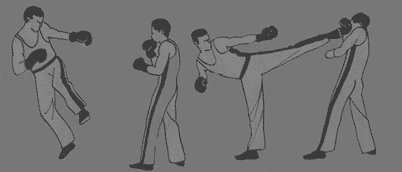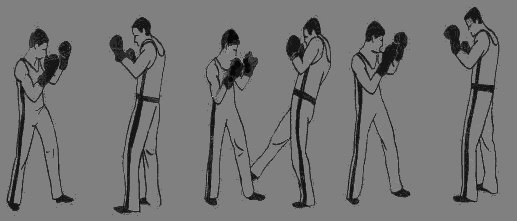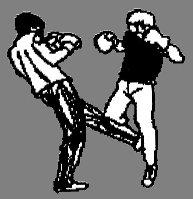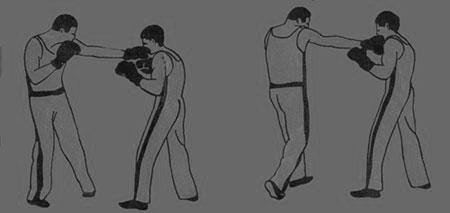Cell:MFS Corsaire/Savate 2
MFS Corsaire Savate Training II
Contents |
"The Chasse" - Kicking
Chasse kicks are straight line kicks that travel with a “piston” like action, pushing out from you to hit a target then returning to a flexed position along the same line or trajectory. There are two forms of Chasse kick, Frontal and Lateral
Chasse Lateral
Chasse Lateral. Lift the knee of the “kicking” foot towards its opposite shoulder, (left knee to right shoulder or vice versa) this motion will cause you to pivot on the supporting leg. Turn the outside edge of the striking leg towards ceiling, calf pressed against thigh. The”kicking” foot should now be pushed out towards its intended target. After hitting target pull leg back to flex before either kicking again or “placing” the foot down.
It is possible to jump, skip or spin into a Chasse Lateral. When using the left leg to kick with, use a strong left arm guard or vice versa using right leg.
Target area’s for Chasse kicks.
Bas: Front face of legs. (Above the knee but below groin.)
Median: Front of body. (Stomach, solar plexus and sternum.)
Figure: Front of head / face.
This illustration shows a fighter delivering a Chasse Lateral to mid section and head. In all of these illustrations the left arm should be slightly more bent at the elbow to create better protection for the head
This illustration shows a fighter delivering a Chasse Lateral Bas, in the first picture his left knee is raised towards the right shoulder, which causes the fighter to pivot upon his supporting leg. He then pushes the sole /heel of the striking leg straight at the target area, if kick is aimed at low line target (as in this illustration) the supporting leg is bent to increase reach and lower centre of gravity.
This illustration shows a chasse marche croise – moving to adjust distance between kicker and opponent. Note the right leg crosses behind the kicking leg before being raised to its opposite shoulder, in this illustration the kick is aimed at mid section
Chasse Frontal
Chasse Frontal: When delivering this kick, remain “square on” to opponent. Raise kicking legs knee towards its same shoulder, (left knee to left shoulder or vice versa) push the heel or sole of the striking foot towards proposed target. After hitting target pull leg back to flex before either kicking again or “placing” the foot down. The kicker should keep both arms flexed in front of them, elbows touching each other to protect against possible incoming attacks
This illustration shows the kicker “chambering” the knee before delivering a Chasse Frontal to mid section. To increase the efficiency of this kick the kicker’s hips and shoulders should be in line with each other. In order to gain distance, a “skip” or forward jump can be added from the chambered position, as the supporting foot should touches the ground the fully extended kicking leg hits it’s target.
In this illustration the kicker has jump / skipped into a chasse lateral to the head, the fully extended kicking leg should contact with the target at the same time as the supporting leg touches the floor. The skipping / jumping motion makes this “saute” kick a very powerful technique, if aimed at the mid section it can create a lot of room between fighters, by pushing one fighter clear across the ring.
"Coup De Pied Bas" - Sweep Kicking
This kick has two purposes that are different depending upon whether you use the front or rear leg to perform the kick. In both cases the kicking leg pivots from the hip and remains fully extended, the foot acting like a match striking across the floor, lifting from the floor at the last possible moment and striking just above the opponents ankle.
Front leg coup pied bas
This kick is used to sweep opponents feet away from beneath them. It travels in a circular motion and the inside, front third of the foot is used to make contact. It must strike below the knee but to be effective the lower the better.
Rear leg coup pied bas
This kick is used to attack the shin/ankle area of an opponent. The foot is “dragged” across the floor then “flicked” up off the ground at the last moment in a straight line towards the target. The inside, front third of the foot is used to make contact; this is a very effective “self defence” kick and is the only kick effective at “very close range.”
In this illustration the kicker starts from a “stance” position, delivers a Coup de pied bas using his rear leg, and then returns to “stance”. Note the chin is tucked in as kicker strikes; this kick is a close range kick so care must be taken to ensure the chin is not exposed to attack.
In this illustration the kicker is trying to unbalance his opponent with a coup de pied bas kick using the front leg. Note the pendulum motion, as the foot sweeps, the head and shoulders pull back out of punching range.
"The Revers" - Reverse Kicking
Revers frontal
Target Areas
Revers lateral
"The Fouette" - Circular Motion Kick
Target Areas
Savate Punches
Jab Punch
Jab. (Direct Bras Avant)
A straight punch given with the lead arm. When delivering the punch, the pelvis and shoulders are utilized by the action of pivoting on the ball of the front foot. This gives added range and power.
Cross Punch
Cross. (Direct Bras Arriere)
Another straight punch but this time given with the rear arm. Once again, when punching the pelvis and shoulders are utilised by the action of pivoting on the ball of the rear foot.
With both punches, the chin is tucked against the collar bone with sight fixed along the striking arm. The glove of the other arm is held in protection to guard the jaw line. Once the target is struck, the striking arm is retracted quickly to reform one’s guard.
These two long-range punches are the most commonly used hand techniques in nearly all fighting arts. The Jab is an excellent opening punch when putting together any punch combination; it is often thrown as a dummy or feint to draw an opponents attention.
